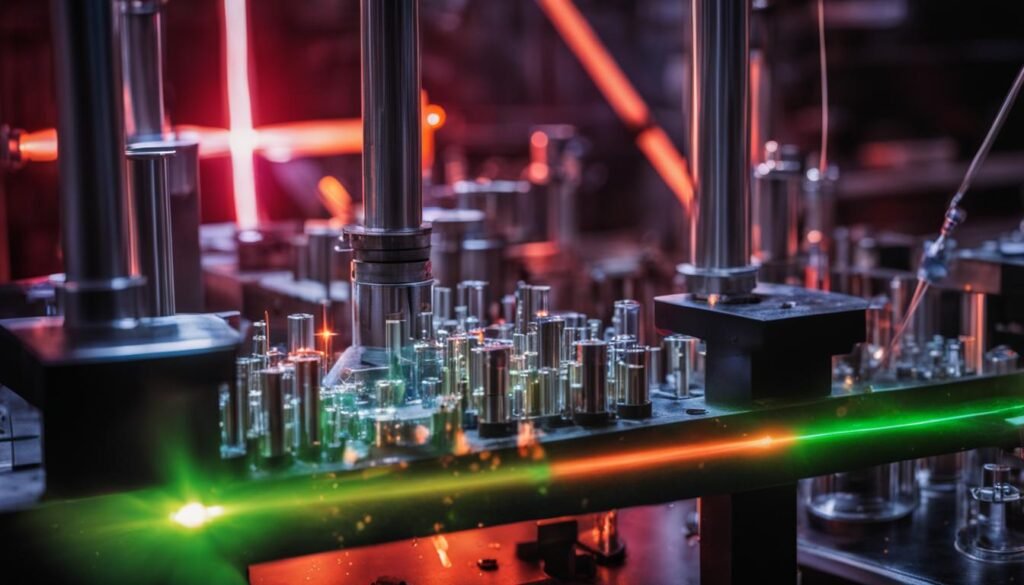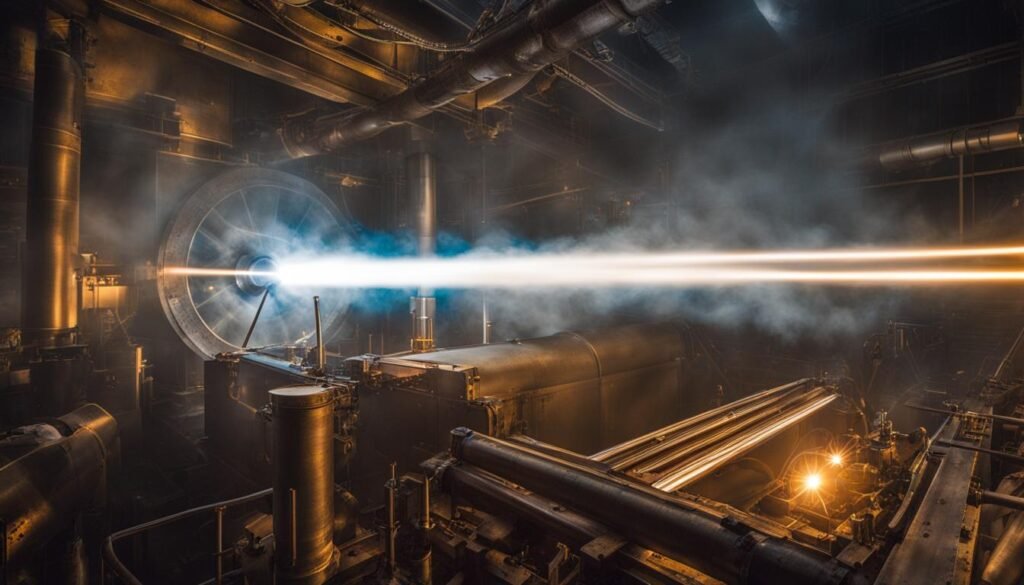Contents
- 1 Structure and Properties of Carbon Nanotubes
- 2 High-Temperature Methods for Laser Synthesis of Nanotubes
- 3 Plasma Arcing Method for Laser Synthesis of Nanotubes
- 4 Conclusion
- 5 FAQ
- 5.1 What is Laser Synthesis of Nanotubes?
- 5.2 Who discovered Laser Synthesis of Nanotubes?
- 5.3 What are the advantages of Laser Synthesis?
- 5.4 What are the different types of carbon nanotubes?
- 5.5 What are the properties of carbon nanotubes?
- 5.6 What are the high-temperature methods for Laser Synthesis?
- 5.7 What is the Plasma Arcing method?
- 5.8 What are the challenges of Laser Synthesis of Nanotubes?
- 5.9 What is the future of Laser Synthesis of Nanotubes?
- 6 Source Links
Laser Synthesis of Nanotubes is a groundbreaking method for producing carbon nanotubes using laser technology. This innovative technique was first discovered in 1991 by researcher Sumio Iijima and has since revolutionized the field of nanotechnology. By harnessing the power of lasers, scientists can control the diameter and length of nanotubes, opening up endless possibilities for various industries.
Key Takeaways:
- Laser Synthesis of Nanotubes is a method of producing carbon nanotubes using laser technology.
- It offers precise control over nanotube diameter and length.
- Applications of nanotubes include electronics, materials science, and medicine.
- High-temperature methods like Chemical Vapor Deposition and Laser Ablation are commonly used for nanotube synthesis.
- The Plasma Arcing method shows promise for large-scale production of nanotubes.
Structure and Properties of Carbon Nanotubes
Carbon nanotubes are cylindrical structures composed of graphene sheets rolled into tubes. They can be classified into two types: single-walled carbon nanotubes (SWNTs) and multi-walled carbon nanotubes (MWNTs). SWNTs have a diameter ranging from 1 to 10 nm, while MWNTs have larger diameters of up to a few tens of nanometers. The structure of carbon nanotubes gives them unique properties such as high mechanical strength, electrical conductivity, and thermal stability. These properties make them ideal for applications in fields like electronics, composite materials, energy storage, and sensors.
Furthermore, the size and arrangement of the carbon atoms in the nanotubes determine their specific properties, allowing for tailored applications in different industries. SWNTs, with their smaller diameter and unique electronic structure, exhibit semiconducting or metallic behavior, depending on their chirality. This tunability of electronic properties makes them highly desirable for nanoelectronics and quantum computing. MWNTs, on the other hand, offer enhanced mechanical properties due to the presence of multiple concentric walls, making them suitable for reinforcement in composite materials.
One important aspect of carbon nanotubes is their aspect ratio, which refers to the length-to-diameter ratio. This aspect ratio plays a significant role in determining the mechanical properties of the nanotubes. Longer nanotubes with a higher aspect ratio exhibit exceptional strength and flexibility, making them ideal for applications requiring high tensile strength. On the other hand, shorter nanotubes with a lower aspect ratio are suitable for applications where flexibility and bendability are desired, such as in flexible electronics and wearable devices.
Table: Properties of Single-Walled Carbon Nanotubes and Multi-Walled Carbon Nanotubes
| Property | Single-Walled Carbon Nanotubes (SWNTs) | Multi-Walled Carbon Nanotubes (MWNTs) |
|---|---|---|
| Mechanical Strength | High | Higher than SWNTs |
| Electrical Conductivity | Semiconducting or Metallic (chirality dependent) | Varies with arrangement of walls |
| Thermal Stability | High | High |
| Aspect Ratio | Varies | Varies |
The properties of carbon nanotubes make them a subject of intense research and hold immense potential for technological advancements. Scientists and engineers continue to explore new applications and synthesis techniques to harness the unique characteristics of these nanomaterials.
High-Temperature Methods for Laser Synthesis of Nanotubes

High-temperature methods play a crucial role in the Laser Synthesis of Nanotubes, offering precise control over the growth process and the production of high-quality nanotubes with desired properties. One of the commonly used methods is Chemical Vapor Deposition (CVD), which involves the vaporization of hydrocarbon gases in the presence of metal catalysts. During CVD, the hydrocarbon gases undergo pyrolysis at high temperatures, causing the carbon atoms to deposit and grow into nanotubes on a substrate. This method provides the ability to control the nanotube diameter and length, making it suitable for various applications in nanotechnology research.
Another high-temperature method is Laser Ablation, where a graphite rod is bombarded with laser radiation to create carbon nanotubes. The high-energy laser pulses vaporize the graphite, leading to the formation of a plasma plume that contains carbon species. The carbon species then condense and form nanotubes on a substrate. Laser Ablation offers advantages such as excellent control over nanotube diameter and high yield production. However, it requires precise control of laser parameters and can be complex and expensive, limiting its large-scale production.
In summary, high-temperature methods like Chemical Vapor Deposition and Laser Ablation are effective techniques for the Laser Synthesis of Nanotubes. These methods enable precise control over the growth process and the production of high-quality nanotubes with specific properties. While they have their respective advantages and challenges, they contribute significantly to nanotechnology research and hold promise for future advancements in various industries.
Comparison of High-Temperature Methods for Laser Synthesis of Nanotubes
| Method | Principle | Advantages | Challenges |
|---|---|---|---|
| Chemical Vapor Deposition (CVD) | Vaporization of hydrocarbon gases in the presence of metal catalysts |
|
|
| Laser Ablation | Bombardment of a graphite rod with laser radiation |
|
|
Plasma Arcing Method for Laser Synthesis of Nanotubes

The Plasma Arcing method is an innovative approach for the Laser Synthesis of Nanotubes. This method utilizes electric arc discharge between graphite electrodes in the presence of an inert gas, such as helium. The electric arc vaporizes the graphite rods, resulting in the creation of a plasma that contains carbon ions. These carbon ions then deposit and grow as nanotubes on a cathode. The Plasma Arcing method provides an efficient way to produce high-quality nanotubes with precise control over their diameter and length.
The Plasma Arcing method offers a promising solution for the large-scale production of nanotubes. By carefully calibrating parameters such as electrode distance, current, and gas pressure, researchers can optimize the synthesis process. This technique has the potential to meet the growing demand for nanotube materials in various industries.
Compared to other high-temperature methods, such as Chemical Vapor Deposition and Laser Ablation, the Plasma Arcing method offers advantages in terms of scalability and cost-effectiveness. While further research is needed to fine-tune the process, the Plasma Arcing method shows great potential for revolutionizing carbon nanotube production.
Applications of Carbon Nanotubes Produced through Plasma Arcing
The unique properties of nanotubes synthesized using the Plasma Arcing method make them suitable for a range of applications. Their high mechanical strength and electrical conductivity make them ideal for use in electronics, such as transistors and sensors. Additionally, their thermal stability and lightweight nature make them suitable for composite materials, offering enhanced strength and durability. Nanotubes produced through Plasma Arcing also hold promise in the field of energy storage, as their high surface area can improve the performance of batteries and capacitors.
The table below highlights some of the potential applications of carbon nanotubes synthesized using the Plasma Arcing method:
| Application | Description |
|---|---|
| Electronics | Nanotubes can be used in transistors, sensors, and other electronic components due to their excellent electrical conductivity. |
| Composite Materials | Addition of nanotubes to polymers or metals can enhance strength, stiffness, and thermal conductivity. |
| Energy Storage | Nanotubes provide high surface area for improved performance in batteries and supercapacitors. |
| Biomedical Applications | Nanotubes can be used in drug delivery systems, tissue engineering, and biosensors due to their biocompatibility. |
As research and development in the field of carbon nanotubes continue, new applications and advancements are expected to emerge, further driving the demand for nanotube synthesis techniques like Plasma Arcing. With its potential for large-scale production and precise control over nanotube properties, the Plasma Arcing method holds promise in revolutionizing various industries and contributing to the advancement of nanotechnology as a whole.
Conclusion
Laser Synthesis of Nanotubes is a highly advanced method that allows for precise control over the production of carbon nanotubes. Its versatility and unique properties have made it an essential tool in nanotechnology research. Through laser technology, researchers can produce single-walled carbon nanotubes, unlocking a wide range of potential applications in electronics, materials science, and medicine.
While the future of laser synthesis of nanotubes is promising, certain challenges need to be addressed for widespread adoption. High production costs and scalability remain significant hurdles that hinder the commercial viability of this technology. However, ongoing research and development are focused on optimizing the process, with the aim of overcoming these challenges and making laser-synthesized nanotubes more accessible.
Looking ahead, the future of nanotube research holds great potential for further innovation and breakthroughs. As scientists continue to explore the properties and applications of nanotubes, new synthesis techniques and exciting advancements are on the horizon. The ability to tailor the properties of nanotubes opens up possibilities in various industries and paves the way for the development of novel technologies.
In conclusion, laser synthesis of nanotubes is an exciting field that has revolutionized nanotechnology research. With ongoing efforts to optimize the process and overcome challenges, we can expect to see even greater advancements in the applications and commercialization of nanotubes in the near future.
FAQ
What is Laser Synthesis of Nanotubes?
Laser Synthesis of Nanotubes is a method of producing carbon nanotubes using laser technology. It involves heating and vaporizing carbon sources in the presence of catalyst nanoparticles to form nanotubes.
Who discovered Laser Synthesis of Nanotubes?
Laser Synthesis of Nanotubes was first discovered by researcher Sumio Iijima in 1991.
What are the advantages of Laser Synthesis?
Laser Synthesis offers advantages such as the ability to control nanotube diameter and length, as well as the production of single-walled carbon nanotubes.
What are the different types of carbon nanotubes?
Carbon nanotubes can be classified into two types: single-walled carbon nanotubes (SWNTs) and multi-walled carbon nanotubes (MWNTs).
What are the properties of carbon nanotubes?
Carbon nanotubes have unique properties such as high mechanical strength, electrical conductivity, and thermal stability.
What are the high-temperature methods for Laser Synthesis?
High-temperature methods for Laser Synthesis include Chemical Vapor Deposition (CVD) and Laser Ablation.
What is the Plasma Arcing method?
The Plasma Arcing method is an approach for Laser Synthesis that involves the use of electric arc discharge between graphite electrodes in the presence of an inert gas.
What are the challenges of Laser Synthesis of Nanotubes?
Challenges of Laser Synthesis include high production costs and scalability.
What is the future of Laser Synthesis of Nanotubes?
The future of Laser Synthesis holds great potential for further innovation and the realization of the full commercial potential of carbon nanotubes.



